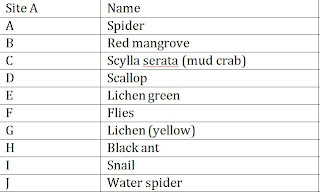We
went to two sites of mangroves and took measurements of the biotic and abiotic
factor. The type of mangrove that we investigated was the red mangrove. By
using a continuous belt transects, the population of each species sighted was
accounted for. The abiotic factor of each site was also measured. Abiotic
factors that were measured included the temperature, DO, pH, TDS, substrate,
water quality, turbidity, depth of water, and light intensity. To further
strengthen the accuracy of our data, we were divided into teams, and each team
had their own data. I was in the Pink Dolphin’s team, and was therefore
responsible for the data, and the data shown below will be of Pink Dolphin’s
property.
Table 1: Abiotic Factor for
Mangrove Site A
Table 2: Abiotic Factor for
Mangrove Site B
The
mangrove ecosystem according to the abiotic factors collected, is a humid
ecosystem with a pH of around 7. Total dissolved solid’s number was high, and
so was the turbidity of the water, making the water’s appearance to become
murky. There was a great deal of sediment inside the water, and as a result,
the light intensity through the water wasn’t very high as the sediments blocked
the sunlight. I learned that there were more than one type of mangroves. There
were red mangroves, and mangroves that were colored in bright yellow, and ones
that was smaller in size compared to the other mangroves. All of these
different kind of mangrove ecosystem had their very own biotic and abiotic
factors making them unique individually.
Figure
1: Biotic Factor for Mangrove Site A
Table 3: Species’ names for Mangrove Site A
As an example, a bar graph of the biotic factors for Mangrove
Site A has been created. Mangrove Site A is the ecosystem belonging to the Red
Mangroves. Even though the ecosystem belongs to the Red Mangroves, their
population are equal or smaller than other organisms because of their size. One
red mangroves has roots called prop roots, which covers a lot of space due to
its size. In contrast, the number of lichen (both yellow, and green) is
numerous in their population. Lichens are indicators, indicating that the area
has a decent air quality, as they only flourish in such environment. Other
organisms were also sighted, however due to the limitation of our mobility due
to the preservation of mangroves, we were unable to dig further down to
investigate and account for smaller organisms hiding out underground.
Here is a
picture of fellow pink dolphins investigating the mangroves.





No comments:
Post a Comment